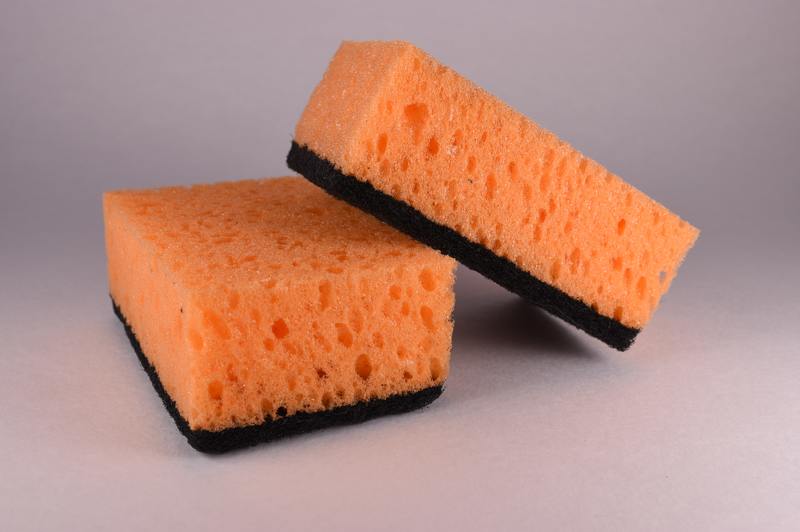Mold and bacteria can be found in your household sponge, and it would greatly help you know how to remove mold from sponge. Keeping your house mold-free is an excellent practice to have.
Remember that molds can grow anywhere, even in your sponge. Household sponges, kitchen sponges, or bath sponges are subjected to water almost all the time.

For fungi such as molds, water is essential as it tends to grow in places with moisture present. Grease and oil can also help trigger the growth of a mold colony.
Sure, you can throw your moldy sponge away and buy a new one, but if you are on a tight budget or keen on helping reduce our waste, there is a way to restore and preserve your sponge from molds. All you need to do is follow the four ways to get rid of mold in your sponge.
Molds can definitely get you sick, that’s for sure. That is why keeping it out from your household utensils, such as the sponge that you use to wash your plates, is a must-do.
After all, nobody likes moldy and dirty sponges getting in contact with their food utensils.
Getting Rid Of Molds From Your Sponge
There are several ways to get rid of molds from your sponge. You can try to do some of them and figure out the best way to remove a mold build-up in your sponge.
Here are some ways to do it.
1. Mold removal using your dishwasher
One of the most effective ways of mold removal from your sponge is using the dishwasher. Throw the sponge in the dishwasher and run it in a high heat cycle with a dishwashing detergent.
Place the sponge on a separate cycle with the utensils for sanitary practices.
Using the high heat cycle or the “heat dry” settings would kill bacteria and mold almost a hundred percent. This also helps remove any foul odors that reside in your sponge.
2. Microwave mold removal process
Microwave, which is basically used to heat and cook food, can also help in effectively killing mold and bacteria that reside in your kitchen sponge. Using high heat, a microwave zaps the mold spores present within the sponge and effectively kills the entire colony growing from within.
3. Mold removal with bleach
Another thing that you can do to remove the molds that have grown on your sponge is to soak it in bleach. Soaking your sponge in a bleach solution has been verified to kill most of the bacteria and mold that can cause diseases.
Mix up bleach with water to make a 10% solution, and let your sponge soak in the solution for about 10 minutes.
After letting the bleach solution seep through the sponge, wring out the sponge and take as much of the key. Make sure that you wear appropriate gloves when handling the bleach, lest you end up having scorched hands.
Rinse the sponge with water, and if it smells, wash it with soap until the odor is gone, then hang the sponge to dry.
4. Mold removal with lemon juice or deionized water
The other substances that had been tested for removing mold from sponges are lemon juice and deionized water. After all, wouldn’t it be nice to have a readily available remedy in your kitchen?
Lucky for you, these two had been proven to just be as effective as bleach against those unsightly molds.
The way to use lemon juice and deionized water is quite similar to the bleach solution. However, you no longer need to dilute the mixture as much as with bleach.
You can use 100% deionized water and about 50-70% solution of lemon juice to soak your sponge. Do note, though, that these substances are used in treatment separately.
After getting your sponge cleaned, you might want to take things further with this article on how to fix water damage under sink.
Should you still use a sponge that has mold?
A sponge infested with molds is unsanitary. However, a molded sponge that has undergone cleansing is safe to use as long as a proper method was observed during the cleaning process.
Molds are dangerous for sure, but it is not something that stays forever. However, it’s a must to wear protective equipment when you clean it.
For dealing with a moldy sponge, something to cover your face will do and here’s an article about what kind of respirator you need for mold.
Sure, you can throw away your molded sponge and buy a new one, but cleaning and reusing is budget friendly. By using substances that kill mold spores, the growth of a mold colony can be stopped and prevented further.
Objects that have been cleaned of mold are very safe to reuse as long as they are cleaned effectively.
Conclusion
Removing mold from your household utensils and keeping it out is something that you must practice all the time. Knowing how to remove mold from sponge can help you maintain a healthy household free from the dangers of mold.
You must never forget that prevention is better than cure. Like everything, there is always a cause for mold infestation.
As long as you can prevent the necessary condition for a mold colony to the surface, you can avoid getting mold problems. Constant monitoring and cleaning will be sufficient enough to prevent mold growth in your house.
